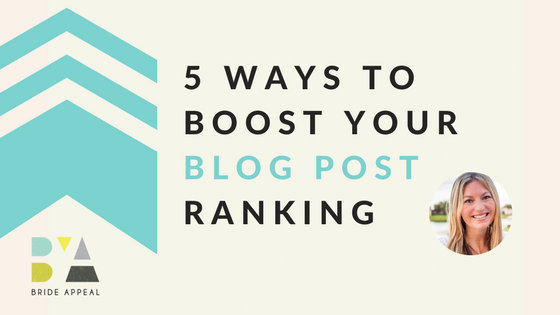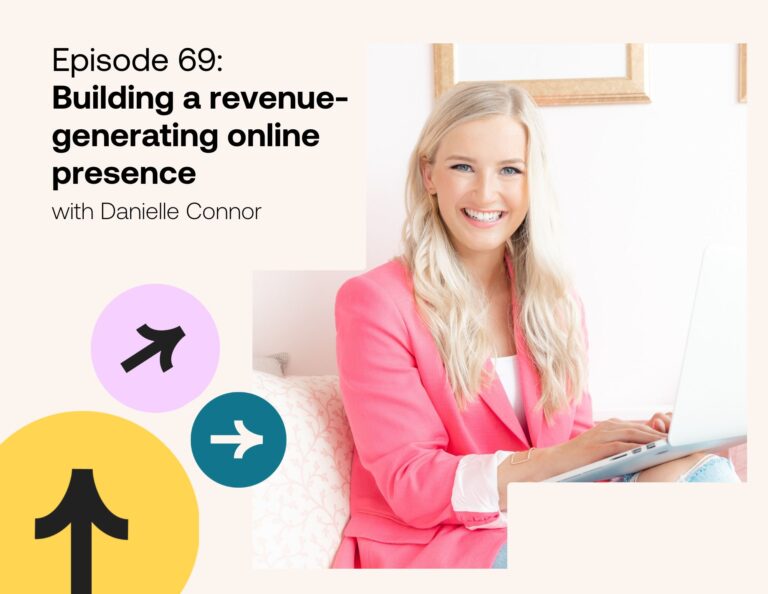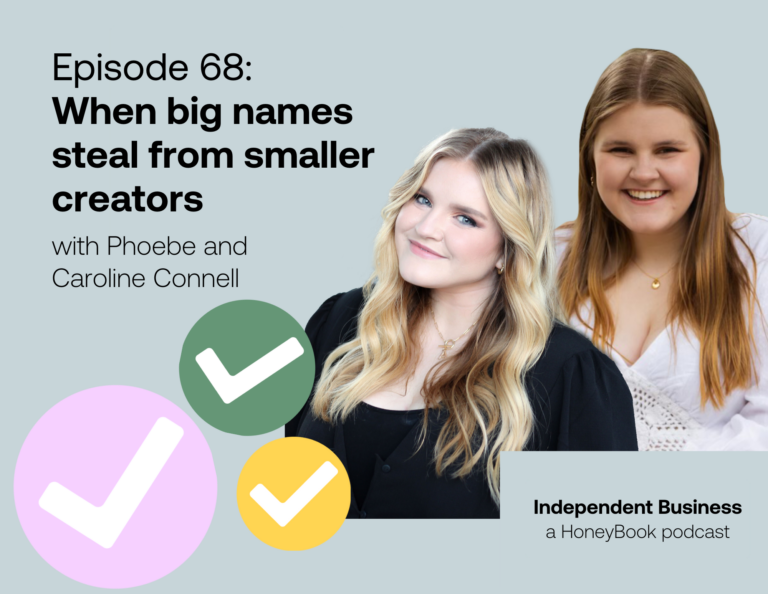5 Ways to Boost Your Blog Post Ranking
You’ve poured your heart and soul into a pretty epic blog post that took days to write, but it’s buried somewhere on the 3rd or 4th page of Google, so no one is finding it.
And no readers means no leads.
So let’s give that blog post of yours the lift it needs to get Google’s attention.

HOW GOOGLE RANKS YOUR STUFF
If you understand only one thing about SEO, make it this: Google’s loyalty is to its searchers, not the websites it’s ranking (unless you’re paying for ads).
This means that Google’s #1 priority is making its searchers happy.
If the person searching for a solution on Google finds it and is happy with it, Google has done its job. If you happen to be that solution, you get rewarded with better rankings.
This means that no matter how perfectly optimized your blog post is, if people don’t love it, Google won’t rank it.
Google looks for certain user behaviors to determine if people like your stuff. If they do, it gives you a bump in rankings.
I call these “happy signals” and you have the power to influence them!
Let’s explore 5 simple tweaks you can make to improve your blog post’s “happy signals” and get more love from Google.
#1. GET MORE PEOPLE TO CLICK
Clicks. They’re like votes. Searchers pick and choose which websites they want to visit in the search results and those clicks become votes for those sites.
The more clicks a site gets, the more its ranking will improve. It’s one of Google’s “happy signals.”
You see, Google understands that clicks mean people are, at the very least, interested in your content. If search engine users click your website over other websites listed in the search engine results page, or SERP, it’s an indication that your content is more worthy of ranking for that keyword.
So if you want your blog post to rank higher, make it more clickable!
I used this strategy to push one of my blog posts from the bottom of Google’s Page 2 to the #1 position in Google in just a few months.
By creating a more clickable headline, I was able to gradually increase the click through rate (CTR) from 11.97% to as high 38.71%, which earned me multiple Page 1 rankings and a #1 position too.
You can do the same.
By modifying your blog post headline, or Title Tag, to be more interesting, entertaining or intriguing, you can lure more searchers to click on your blog post.
Need headline inspiration? Here are 3 tips:
1. Scour the cover of any lifestyle magazine in the grocer checkout line. It will be littered with headline ideas you can swipe for your own article.
2. Visit Q&A site like Quora or Yahoo Answers. Type in searches generally related to your blog post, but not too specific. This will help you find the type of language real people use when they have questions on that topic. Using their own words will make your headline more relatable.
3. If you want to dive deeper into this step, I wrote a full article on this topic of getting more clicks on your Google organic listing with even more strategies you can use to make your Title Tags more clickable.
Once you craft the perfect headline, change the Title Tag of your blog post to the new, more compelling headline you created.
Tip: Your Title Tag is probably just your blog post title, so you may not have to touch any code. You can ask your developer.
#2. GET MORE PEOPLE TO STAY
If getting more people to click is a “happy signal”, then it makes sense that getting more people to stick around is too.
Think about it.
If someone clicks on your website from Google but immediately leaves, then it’s pretty obvious that your content wasn’t what they were hoping for.
At least, that’s how Google would interpret it.
They call it Bounce Rate; the percentage of visitors that immediately leave your webpage after arrival.
You can find out the bounce rate on your site by using the free Google Analytics tool.
If people are landing on your blog post and leaving right away, it’s a pretty strong indication to Google that your post either isn’t a great match to what they were searching for or isn’t that helpful of a resource.
A low bounce rate tells Google that your webpage is more worthy of rankings. Your goal is to get your percentage as close to 0% as possible.
So how do you lower your bounce rate?
Simple, make sure your blog post is a good answer to their search query.
People won’t leave right away if what they find is the answer they’re looking for.
1. A great place to start is with your blog post title. Since this is usually the “headline” searchers will see and click on from the search engines, you want to make sure that your blog post content lives up to it. The name of your blog post is like a promise and the substance within the post needs to deliver on that promise.
A simple way to audit your title is to ask yourself “if my blog post title were a question, would the content in my post answer it?”
2. Another way to lower bounce rate is to open up your post with a powerful intro paragraph. An interesting story, a popular question or a shocking fact that captures attention right out of the gate can stick your visitor to your post.
Multimedia can be helpful too. Starting your post with a video or eye-catching image could be just the thing to entice readers to stick around.
#3. GET READERS TO STAY LONGER
No one is going to stay on your website for very long if they don’t like what they’ve found. Thus, “time on page” is a “happy signal” too.
The longer people stay, the more likely they’re enjoying your content.
So while a low bounce rate tells Google that people have found what they’re looking for, a high time on site tells Google that people like what they’re reading.
Getting visitors to stay on your blog posts is a bit of an art, so here is a great opportunity to leverage that beautifully creative mind of yours.
To get you going, here are a few ideas for how to make your posts too good to leave:
– Length: The longer your post, the more reason visitors have to stay. If your post is only 300 words, then readers simply don’t have a need to stay very long and the ‘time on page’ will be brief, simply by nature of the post itself.
– Value: Whether it’s helpful, instructive, inspiring or entertaining, the more valuable your blog post is to your visitors, the more likely they’ll trade their time for it. If you’re not sure what your unique audience finds valuable, feel free to check out this simple strategy to uncover the exact types of blog posts your audience wants to read (this strategy will be useful to you even if you are not in the wedding industry.)
– Relatable: Pull your readers in with stories they can relate to. The more they empathize with your post, the more likely they’ll feel it’s relevant to them on a personal level and want to stay.
#4. GET READERS TO SHARE
Social media is like validation for the popularity of your blog posts. If people like your post enough to share it across social platforms, it’s got to be worth something, right?
Social shares, comments and likes, especially on publicly accessible platforms like Twitter and Pinterest, are other “happy signals” Google can utilize to gauge the worthiness of your post to be ranked.
Here are a few ways to jazz up your social signals:
– Better content will naturally attract social engagement, so focus on making your post worthy of sharing in the first place.
– Add social sharing buttons to your blog to encourage easy sharing.
– Ask readers to share your post at the end of the article to prompt activity.
– Share your blog posts on your own social profiles to kick things off.
– Tag users in your social posts who are mentioned in your blog post to prompt them to re-post.
Want an extra social boost? Grab my free Social SEO in 5 Minutes a Day email course.
#5. GET A LINK TO YOUR POST
Inbound links are like the currency of SEO. The more you obtain and the higher their value, the more they help push your blog posts up the rankings.
One of the simplest way to get a quick, high value link to your blog post is to link to it yourself when guest posting.
Here’s what to do:
1. Approach one of your industry peers about writing a helpful guest post for their blog, written specifically with their unique readers in mind.
2. Make the topic of your guest article different from your blog post on your own site, but relatable enough that you could mention your blog post within it.
3. Then, when you mention your blog post within your guest article, link to it within the body of that guest post.
Voila! Inbound link created.
NOW GO BOOST YOUR BLOG RANKING
These tips are so incredibly simple you can implement them this week.
Choose one blog post to focus on and set aside an hour or two to execute these ideas this week.
Then, monitor your rankings for the keywords you’re targeting and watch your post inch closer to the top over the coming weeks.
Once you’ve done that, consider boosting your business with HoneyBook’s small business management platform.



